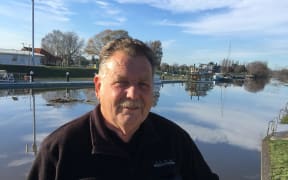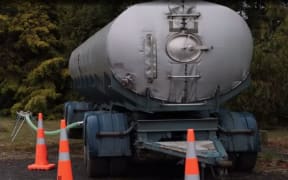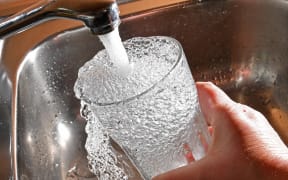
Photo: RNZ
A scientist says Waimate's drinking water nitrate contamination could be linked to recent changes in land use, including wastewater discharge from Oceania Dairy's factory in South Canterbury.
Since August, 615 residents using the Lower Waihao Rural Water Scheme's water have been warned against drinking tap water due to high nitrate levels.
The Waimate District Council previously suggested flooding in the region was to blame, and Environment Canterbury thinks it is unlikely the dairy factory is a factor.
But University of Otago public health specialist Dr Tim Chambers said: "It looks like the Oceania Dairy Factory could be playing a part."
Nitrate is tasteless, odourless and can't be removed by boiling water. High levels are associated with the rare but fatal "blue baby syndrome" and more recently some studies have linked them to an increased risk of cancer, preterm births and neural tube defects.
Current rules in New Zealand allow for 50mg/L of nitrate in drinking water, or 11.3mg/L of nitrate nitrogen.
Waimate residents affected by the contamination have been getting water from tanks at two local halls or a tap on Hillary Street.
Chambers said there had been elevated nitrate levels in some wells closest to where Oceania Dairy spreads wastewater from dairy processing since a resource consent was granted in 2015.
Oceania Dairy's factory in Glenavy has permission to spread wastewater containing up to 400kg of nitrogen per hectare per year on up to 316 hectares of ungrazed land close to the factory until 2045.
Farmers are allowed to spread up to 190kg per hectare per year of nitrogen in synthetic fertilisers on grazed pasture.
"Looking at well data obtained from Environment Canterbury by Otago University on the specific issue in Waimate and Glenavy, it looks like the Oceania Dairy Factory could be playing a part with its nitrogen-rich wastewater," Chambers said.
Calcium had also increased in wells close to where the wastewater is spread, and in the drinking water well.
"One of the things that stuck out for us was that between those two wells, it seems like there's been quite a big increase in both nitrate and calcium since 2015. The increasing calcium was particularly interesting, because we wouldn't expect or know why there'd be an increase in calcium in those two wells and not in other wells in the same area."
Nitrate levels could also be raised by extreme rainfall, an increase in livestock numbers, and irrigation changes, he said.
More research was needed to confirm whether factory wastewater could be affecting Waimate's water supply.
"[There's] a lot of unanswered questions, but ones that need to be answered for us to have a better understanding of the nitrate contamination in the area."

Photo: RNZ
In a statement, Oceania Dairy's general manager Logan Hanifan said bores which supplied the factory were tested monthly for nitrate.
"No elevated levels of nitrate have been detected in these bores which are in very close proximity to land on which our treated wastewater is dispersed."
Oceania was "extremely disappointed" by a Greenpeace press release which raised Chambers' concerns that the factory's wastewater could be contributing to the nitrate levels, Hanifan said.
Waimate District Council group asset manager Dan Mitchell said the drinking water warning for local residents remained in place, although nitrate levels had dropped below the 50mg/L maximum allowed level to 37mg/L.
Staff at the council felt it was difficult to conclude the factory's wastewater had impacted the drinking water supply. Any investigation into what was causing the high level of nitrate in the water supply would sit with the regional council, Environment Canterbury.
The council was planning to permanently lower nitrate levels by upgrading its water treatment plant, a process unlikely to be completed until at least mid-2023.
The council needed to balance economic, environmental and health impacts, Mitchell said. A new system would cost between $500,000 and $750,000, plus ongoing operational costs. Three other additional processes, which had not yet been costed, were also being considered.
Although Environment Canterbury issued consents for discharging contaminants, like wastewater, to land, it said it was not responsible for the water supply and would not be contributing to costs for denitrification.
Oceania Dairy's resource consent, issued by Environment Canterbury, includes rules for monitoring the groundwater quality. This includes bores installed by Oceania Dairy up and downstream of where the wastewater is spread, as well as monitoring private bores in a 3-kilometre radius.
Environment Canterbury was unable to provide RNZ information about whether the monitored wells had breached limits before publication, but results previously supplied to Chambers as part of an Official Information Act request showed one bore monitored by Oceania Dairy had breached drinking water limits for nitrate nitrogen at least 12 times since 2015. A bore in a property neighbouring where the wastewater spread had breached standards at least three times.
Environment Canterbury's Southern Zone lead Peter Burt said even if nitrate levels in the monitored wells were higher than drinking water standards allowed, it did not mean Oceania Dairy had breached its consent, or was linked to the nitrate issues with the drinking water.
"We have not been in touch with Waimate District Council on the subject of Oceania consent condition exceedances. We are, however, in regular contact with Waimate District Council relating to the Lower Waihao drinking water issue and supporting them with technical advice."
He believed it was unlikely the factory was the cause of Waimate's water issues.
In a news item published on its website in September, Environment Canterbury said heavy rain events in July were a likely contributor to the nitrate levels in the water supply.
Burt said the factory was downgradient from the water supply's intake.
Ashley Corner, the acting head of regulation for the recently established drinking water regulator Taumata Arowai, said its role was to ensure drinking water supplied to residents was safe but it was not involved in establishing causes of contamination. It was comfortable with the council's handling of the issue.
If drinking water quality was impacted by a consent issued by a regional council a review of the conditions of a consent could be requested, Corner said. There could also be other actions possible under the Resource Management Act to address adverse environmental effects.
Greenpeace has campaigned for drinking water standards for nitrate to be 11 times lower than they currently are. It has organised a public meeting on nitrate contamination with Chambers, to be held on Tuesday 15 November at 7pm in the Glenavy Hall.
Senior campaigner Steve Abel said the organisation was also offering free water testing to residents who had private bores, at the Glenavy Hall from 10am to 4pm on Tuesday, and at Waimate Highland Pipe Band Hall on Wednesday morning from 9am to 12pm.
"To me, the presence of calcium with nitrate is a smoking gun which could indicate the dairy factory wastewater is playing a part in the high nitrate levels," said Abel.
"It is unacceptable that the people of the Waimate region have lost their water supply because of nitrate contamination, and local residents deserve information and answers."





